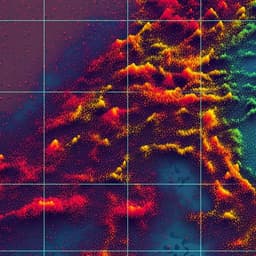
Environmental Studies and Forestry
Towards comprehensive air quality management using low-cost sensors for pollution source apportionment
D. Bousiotis, G. Allison, et al.
This groundbreaking research showcases a cost-effective method for air pollution source apportionment using low-cost sensors and advanced analytic techniques. Conducted by Dimitrios Bousiotis and colleagues from the University of Birmingham, alongside Gordon Allison from DustScan Limited, the study reveals critical insights into pollution sources across various sites, with significant implications for air quality management.
~3 min • Beginner • English
Introduction
The study addresses the challenge of identifying and apportioning sources of particulate matter (PM) pollution to enable effective air quality management. While poor air quality causes major health impacts globally, effective control requires knowledge of pollution sources and their relative importance, not just concentration measurements. Traditional source apportionment using research-grade instruments is costly and logistically challenging. Low-cost sensors (LCS) have improved substantially and are widely used for PM monitoring but have seen limited application in source apportionment, especially in complex urban settings. This work tests whether PM size distribution data from low-cost optical particle counters can, when combined with k-means clustering and Positive Matrix Factorization (PMF), identify and quantify key PM sources at three sites (construction, quarry, roadside) in central England, thereby providing a lower-cost path to targeted pollution control.
Literature Review
The paper situates its contribution within prior work showing: (a) the health burden of PM exposure; (b) established receptor modeling techniques, notably PMF and clustering, for source identification/apportionment using research-grade instruments; and (c) the emergence and increasing reliability of low-cost PM sensors (e.g., Alphasense OPC) with demonstrated applications after appropriate calibration. Previous LCS-based source apportionment focused on simpler, background environments with fewer dominant sources, or used simplified identification approaches. Earlier studies by the authors demonstrated that k-means clustering and PMF applied to LCS-derived PM size distributions can reveal complementary insights into sources and conditions affecting their impacts. This study extends those findings to more complex industrial and roadside environments and evaluates quantitative apportionment capabilities.
Methodology
Instrumentation and data: Alphasense OPC-N3 low-cost optical particle counters measured particle number concentrations across 24 bins from 0.35–40 µm. Sensors cost ~GBP 250, dimensions 75×63.5×60 mm, max count 10,000 s−1, with <1 s time resolution; data were averaged to hourly means. At the two industrial sites, OPCs were directly calibrated against co-located regulatory instruments operated by site operators or DustScanAQ. Measurements were taken ~2 m above ground; original time resolution 1 min, averaged to hourly; data periods selected to avoid missing or negative values.
Sites and periods: (1) Curzon Street construction site, Birmingham, UK (52.48°N, 1.89°W), adjacent to a major railway station construction, south to northeast arc from monitor; 02/09/2020–26/10/2020. (2) Mountsorrel quarry, Leicestershire, UK (52.73°N, 1.16°W), a large quarry with crushing and other facilities; site northeast of crushing area and ~100 m north of other works; 01/07/2021–28/07/2021. (3) Roadside site on Market Street, Charlbury, UK (51.87°N, 1.48°W); 07/10/2021–14/10/2021.
Meteorology: Curzon Street used University of Birmingham met station data (~6–7 km away) to avoid local topography bias; Mountsorrel used a met station a few hundred meters west of the monitor (wind at 5 m); Charlbury used Little Rissington station (~14 km west). Average wind roses provided in Supplementary material.
k-means clustering: Applied to PM size distribution data to identify clusters representing distinct air quality and source conditions. Clustering partitions observations into k groups minimizing within-cluster variance (squared Euclidean distance). Optimal k assessed via Dunn Index and Silhouette width; where ambiguous, solutions best representing site conditions were selected following prior practice.
Positive Matrix Factorization (PMF): Multivariate receptor model solving X = GF + E with non-negativity constraints on G (factor contributions) and F (factor profiles), minimizing the weighted residual norm using uncertainties u. As PMF lacks a unique criterion for the optimal number of factors, the solution providing the most interpretable, site-consistent factors was chosen.
Estimating factor PM mass contributions: For factor i, estimated PM mass contribution PM_est(i) = F_PM(i) × G_i, where F_PM(i) is the mean PM for that factor (with G normalized to mean 1). This yields time-varying estimated PM contributions per factor, acknowledging unexplained variance and shared temporal scaling within each factor.
Analysis outputs: For each site, PMF factor particle number size distributions (PNSDs), diurnal and wind dependence of G contributions, polar plots of estimated PM contributions, and k-means cluster meteorological/PM statistics (Table 1). Factor contributions to PM1, PM2.5, PM10 summarized in Table 2, including unexplained portions.
Key Findings
Curzon Street construction site (Birmingham):
- Both k-means and PMF isolated construction-related super-micron particle sources. PMF identified two construction-associated factors: F4 with peaks ~5 µm and increased PM10 over PM2.5, and F2 with peaks 1–2 µm. Clustering showed multiple clusters (CL1, CL3–CL5) capturing construction impacts, particularly for particles >7–20 µm.
- Temporal patterns linked to earth-moving activities (ceased 21 Sept per works diary), with residual resuspension outside active periods. F4 contributed up to ~60% of PM10 during working hours (5:00–15:00 weekdays); average effect on PM1 ~5%, more than doubling during working hours; reduced impact outside working hours.
- PMF apportioned Curzon Street PM by factor (Table 2): F1 (PM1 55.2%, PM2.5 15.8%, PM10 negligible), F2 (0.2%, 0.2%, negligible), F3 (8.1%, 20.0%, negligible), F4 (1.2%, 5.0%, 33.6%), F5 (27.1%, 50.0%, 38.5%), Unexplained (8.3%, 9.0%, 27.8%). A southeast source (city centre) dominated submicron particles, stronger at night/early morning, likely influenced by boundary layer dynamics.
Mountsorrel quarry (Leicestershire):
- Background PNSDs identified (CL1, CL3, CL4; PMF F1). A quarry-associated factor (F2) showed two spatial components: the crushing area ~500 m SW, and another works area to the south producing smaller particles (0.5–1.5 µm). Downwind SW winds with higher speeds (CL6) increased PM2.5 and PM10 up to ~3× average concentrations, though such conditions occurred ~3% of the period.
- PMF apportionment at Mountsorrel (Table 2): F1 (PM1 70.2%, PM2.5 68.6%, PM10 56.6%), F2 (3.5%, 8.86%, 16.0%), F3 marine (12.4%, 13.4%, 12.0%), F4 (0.7%, negligible, 0.2%), Unexplained (13.2%, 9.2%, 16.2%). F2 accounted for ~17% of PM10 and ~10% of PM2.5 on average; with SW winds, ~32% (PM10) and ~18% (PM2.5). Marine factor F3 contributed ~14% (general) and ~19% (with SW) to PM (site-specific) and may be enhanced by quarry emissions.
- Exceedances: Clustering indicated quarry effects exceeded updated WHO daily limits for ~12% of PM2.5 hours and ~3% of PM10 hours; PMF-based estimates exceeded limits in ~5% of hours, slightly higher when including the SW-enhanced marine factor.
- An additional low-speed, nighttime, likely local source from the northern sector (CL5, PMF F4) contributed modestly to PM.
Charlbury roadside (Market Street):
- k-means identified five clusters distinguishing night/day (CL1 vs CL3), polluted vs clean (CL1/CL2/CL4 vs CL3), and a strong wind parallel-to-road period (CL5). Most polluted conditions were with southerly winds (CL2), aligning with the town centre and a nearby junction; low concentrations occurred with northerly winds parallel to the road (CL5). CL3 and CL4 dominated (~70% combined), with CL4 showing high fine-particle fraction characteristic of traffic influence.
- PMF found three factors: F1, a traffic-associated factor increasing with decreasing particle size and strongest with easterly winds (also potentially town contributions), dominated PM mass; F2, similar PNSD but smaller contributions and stronger with southerly winds, had greater relative impact on PM2.5 and PM1 than PM10; F3, a larger-particle, likely regional/marine-influenced factor with bimodal peaks (<1 and ~2 µm), contributed >20% of PM10, increasing with higher wind speeds and broadly isotropic.
- PMF apportionment at Charlbury (Table 2): F1 (PM1 74.5%, PM2.5 75.0%, PM10 65.2%), F2 (15.7%, 11.4%, negligible), F3 (3.0%, 8.1%, 19.2%), Unexplained (6.8%, 5.5%, 15.6%).
Cross-site findings:
- A consistent marine factor with super-micron PNSD features (peaks ~0.75 µm and ~1.5 µm) was identified at all three sites and in prior BAQS work, demonstrating reproducible PNSD signatures across environments.
- The low-cost approach effectively identified and apportioned sources with super-micron particle contributions, enabling estimation of PM2.5 and PM10 source contributions under real-world meteorological and temporal conditions.
Discussion
The combined k-means and PMF approach applied to low-cost OPC-derived size distributions effectively identified major PM sources and apportioned their contributions across three complex environments. Clustering provided operational insight into site conditions by grouping similar PNSD and meteorological states, revealing when specific sources (e.g., construction/quarry activities, traffic, regional inflow) dominated. PMF isolated distinct factors with interpretable PNSD profiles, enabling quantification of their contributions to PM2.5 and PM10 mass. The methods were particularly successful for sources emitting super-micron particles (e.g., construction dust, quarry operations, marine aerosol), which fall within the OPC measurement range. The construction factor at Curzon significantly elevated PM10 during working hours, and the quarry factor at Mountsorrel contributed substantially when downwind, with increases modulated by wind direction and speed. At the roadside, PMF separated traffic-related fine particle profiles and a regional/marine factor important for PM10, while clustering delineated pollution regimes driven by wind and diurnal traffic patterns.
The findings address the research question by demonstrating that low-cost sensors, with appropriate statistical analyses, can provide actionable source apportionment at a fraction of traditional costs. This enables targeted interventions (e.g., managing nuisance dust) and supports regulatory decision-making. The reproducibility of the marine factor PNSD across sites suggests transferable factor fingerprints, potentially simplifying future source apportionment by reducing the number of unknowns. However, the approach is less sensitive to sub-0.38 µm particles, limiting resolution of regional combustion sources and some traffic emissions, particularly at roadside sites dominated by ultrafine particles. Longer datasets and/or chemical composition measurements can enhance factor attribution and robustness in such settings.
Conclusion
This study demonstrates that low-cost optical particle counters, combined with k-means clustering and PMF, can identify, locate, and quantify key PM sources in complex real-world environments, providing estimates of source contributions to PM2.5 and PM10. The methodology reliably captures super-micron sources such as construction and quarry operations, and consistently identifies a marine-influenced regional factor across diverse sites. By lowering financial and logistical barriers, the approach can broaden the use of source apportionment for regulatory and compliance applications, especially for boundary line monitoring and targeted mitigation of specific emitters. Future work should include field validation against regulatory-grade systems across more environments, integration of low-cost particle number counters to capture ultrafine particles, expansion of sensor arrays for source triangulation, and incorporation of chemical composition and longer monitoring periods to strengthen factor attribution, especially at traffic-dominated sites.
Limitations
- Measurement range limitation: OPC-N3 lower size cut-off (~0.35–0.38 µm) reduces sensitivity to ultrafine particles, hindering identification of regional combustion and some traffic sources; total particle number metrics cannot be assessed.
- Attribution uncertainty at roadside: Short monitoring duration at Charlbury limited PMF factor interpretability; longer datasets and/or chemical composition data would improve source attribution.
- Dependence on calibration and co-location: Accuracy relies on calibration against regulatory instruments (done at industrial sites); performance may vary with aerosol composition and environments.
- Meteorological representativeness: Off-site meteorological data (e.g., 6–7 km for Birmingham; 14 km for Charlbury) may introduce uncertainty in wind-based source localization.
- Unexplained variance: PMF solutions retain an unexplained fraction of PM mass (e.g., up to ~28% of PM10 at Curzon), indicating unresolved sources or model limitations.
- Temporal representativeness: Short campaign lengths (especially the 1-week roadside study) may not capture broader variability across seasons or operational changes at industrial sites.
Related Publications
Explore these studies to deepen your understanding of the subject.







